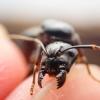I’ve had far better luck utilizing high wattage mercury vapor bulbs than standard fluorescent black light tubes. They emit UV light in the correct spectrum for attracting ants, but more importantly they put out a LOT of light. This seems to attract ants (and a plethora of other insects) from a far larger range. In a flat landscape dense with tree cover such as often found in Florida, a high lumen output has proven incredibly effective for bringing alates in, even from species occurring in biotopes far away from the collection site.
The startup cost for a basic setup runs a bit on the high side, with important items being a proper ballast (some lower wattage MV lights are self-ballasted) for the bulb and a portable power source with decent capacity, as these bulbs suck up a fair bit. They also need housing to protect from moisture (and prevent insects from being immediately cooked when they fly into the light, these bulbs run HOT) which would cause the bulbs to shatter. Eye protection is important too, UVA is particularly damaging to eyes.
Thanks you for the information  . I have already fully researched MV bulbs and while I understand they are the "best" they as you mentioned are, HOT, display light in all wavelengths, and are costly. You literally just provided all the reasons why I started this project. Issue I have other than the MASSIVE power consumption, they are typically 300+ watts, is they produce light in the visible spectrum. As mentioned according to a university small research study, 350nm is the prime spot. This is the issue, because MV DOES emit this wavelength, while UV fluorescent tubes do not. So, as you see, you aren't comparing apples to apples. I want to hit that sweet spot and only that sweet spot with the best wavelength without the wasted energy.
. I have already fully researched MV bulbs and while I understand they are the "best" they as you mentioned are, HOT, display light in all wavelengths, and are costly. You literally just provided all the reasons why I started this project. Issue I have other than the MASSIVE power consumption, they are typically 300+ watts, is they produce light in the visible spectrum. As mentioned according to a university small research study, 350nm is the prime spot. This is the issue, because MV DOES emit this wavelength, while UV fluorescent tubes do not. So, as you see, you aren't comparing apples to apples. I want to hit that sweet spot and only that sweet spot with the best wavelength without the wasted energy.
Maybe, you could do an objective comparison once this has finished?
Sound ideas and I’ll be watching closely.
As for just what wavelength attracts queens, I will say that I’ve had a surprising number of Neviamyrmex males appear around MV, while the other options yielded zero, though this could be an anomaly. I did have clear observations of one male clearly preferring the MV as opossed to a full spectrum fluorescent bulb I was running at the same time. So perhaps they emit something in their wavelength that attracts a species not normally brought in by other lights. Obviously, more testing is required.
Originally, I was going to try using full spectrum also, even bought a 50w full spectrum LED, again, you are thankfully backing up research I done in which these do NOT go below ~380nm, which I know for a fact MV does go into. Meaning, may be more weight to this idea I have. The cost of a 100w 350nm LED is massive or even a 50w (for me), not to mention pain in a** to find, which is why I am trying small scale first with slightly above 350nm. If I get more queens attracted to the lower wavelength, I'll buy the 350nm LED to compare against.
Another challenge that may come about is some queens may like higher wavelengths and others lower, so may have to make multi-LED solution to cover full range.
For kids/people that haven't done the research and are still lost:
nm = nanometers = As you should remember from science class, light is just a form of energy and we measure that light in nanometers. Visible light is ~380-780nm
MV = Mercury Vapor = 100+ watt light bulb most commonly used in scientific work since the light they emit is in a very large range: 250nm-750nm
What I am trying to do is test if ~350nm LED is BETTER than a MV since you will have less loss in power from wavelengths that are less likely to attract insects.
Easy to understand example:
1x 100w @ 350nm gives off roughly:
85 watts @ 350nm,
7.5 watts @ 345-349nm,
7.5 watts @ 351-355nm;
So 85 watts of supposibly sweetspot @ 350nm.
VS
1x 100w Mercury Vapor bulb, giving us:
20watts @ 365nm,
20watts @ 405nm,
20watts @ 436nm,
20watts @ 536nm,
20watts of combined 250-300nm, 304-313nm, and 579nm
Edited by StopSpazzing, April 2 2018 - 4:03 PM.
![]()



























